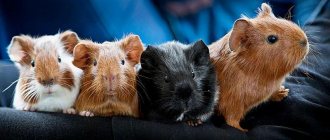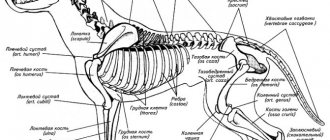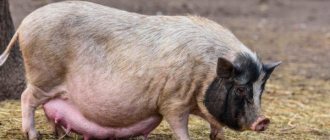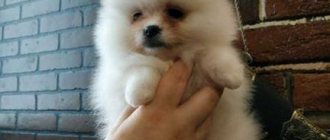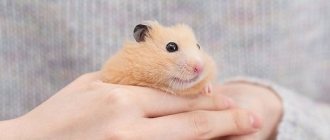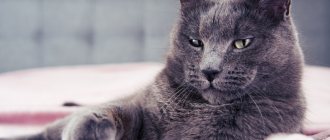Beginning breeders often wonder how many months a pregnant rabbit walks. Rabbits grow and develop very quickly. They also age very early. At the age of three months they acquire the ability to reproduce, but it’s worth taking some time. Pregnancy is a difficult life stage for both the females themselves and the farmer. It is important for livestock breeders to know how long pregnancy lasts for rabbits in order to prepare in advance for childbirth, calculate possible expenses and potential income from increasing the number of livestock.
How do rabbits give birth?
The birth of babies occurs 28-34 days after mating. The more babies, the shorter the gestation period. The breeder will understand that the breeding is approaching by the restless state of the female. In the queen cell, the female rabbit begins to make a nest from straw and wool.
Lambing time is early morning or night. The expectant mother rarely needs the owner's help. His main task is not to interfere, to quietly control the process. The rabbit's maternal instinct is extremely developed; she herself knows what to do. After the birth of the last baby, the female rabbit bites the umbilical cord, licks the children, and eats the afterbirth.
On average, a birth lasts from 20 to 30 minutes. If the female cannot give birth for more than 1 hour, you need to seek help from a veterinarian.
Expert opinion
Zarechny Maxim Valerievich
Agronomist with 12 years of experience. Our best country expert.
Ask a Question
The guide to caring for rabbits at home for beginners says that after lambing you need to carefully inspect the nest and remove dead and weak babies from it so as not to frighten off the mother.
How to tell if a female rabbit is in heat
Before she begins to mate, the female changes her behavior. Her genitals change their condition. The genital slit turns red, and white and red discharge begins to emerge from it. The heat intensifies, and the animal’s nipples begin to swell greatly. The frequency of this condition in females is 40 hours and lasts about a week (sometimes up to one month). At this time, the female's behavior becomes more restless.
Her genitals change their state
How many times a day does a mother rabbit feed newborn rabbits?
How to know that a rabbit is in heat, what needs to be done? The livestock breeder will be helped by observing the female:
- if she aggressively gnaws and scratches the cage bars with her paw, wheezes, snorts, and fights with other individuals, then she should be let out for a walk;
- she carries hay in her teeth from one corner of the cage to another due to the manifestation of an instinct that forces her to build a nest;
- the female can pluck her own down and fur herself;
- the rabbit loses her appetite and stops eating.
You can check the condition of the animal by stroking from its head to the tailbone. If the female is waiting for mating, then she will have a desire to raise her pelvic part.
Important! To speed up the state of hunting, you need to lengthen the daylight hours. Therefore, artificial lighting is used in winter and autumn. If this condition is not met, then there is no need to expect a large offspring.
How many rabbits are born to a female rabbit?
During one lambing, the female rabbit brings from 4 to 12 babies. The number of children depends on the tribe, age, living conditions of the female and diet. Representatives of decorative breeds give birth to up to 6 rabbits at a time, mammals of the medium weight category breed 8-12 individuals, giants can produce up to 16 individuals.
A female who becomes a mother for the first time has a small offspring (3-5 babies). Also, lambing rates are low in obese animals. Their sexual desire weakens, the rhythm of reproduction is disrupted, and the birth itself occurs with complications.
See also
Description and character of colored dwarf rabbits, contentRead
Can a female rabbit give birth to one baby rabbit?
Some breeders ask why only one rabbit is born when more animals are due. This happens quite rarely. This happens either due to the weakness of the expectant mother or the presence of any disease. To prevent this from happening, the female should spend more time in the air and receive a varied diet rich in vitamins and minerals. The breeder must closely monitor the rabbit at all times and call a veterinarian in time if there are problems.
Baby rabbits
How often do they give birth?
Animals of the order Lagomorpha can produce up to 70 rabbits per year. Theoretically, a female rabbit can bear 11-12 litters per year, but lambing is an exhausting process for a female rabbit. Both the body and the female nervous system need rest.
3 breeding technologies:
- Industrial. After successful lambing, breeders re-mating after 21 days. This schedule makes it possible to get 7 litters per year.
- Compacted lambing. Already on the second day after giving birth, the animal enters a state of heat; mating is carried out on the 3rd day after birth. A female rabbit can simultaneously feed babies and bear a new litter. Then, on the 28th day, children should be separated from their mother so that she can prepare for a new birth. The dense birth schedule leads to rapid exhaustion of females, which also negatively affects the health of the offspring.
- Standard. The female is placed with the male 30 days after lambing. After 2 weeks, the children are separated from her, leaving the expectant mother with 14 days to prepare for another birth.
Preference should be given to the 3rd method, as it is the most gentle.
How to care for a pregnant rabbit
The success of bearing offspring directly depends on what kind of care breeders provide to pregnant females. Therefore, the main task is to provide her with coziness, tranquility and comfort during this entire time. You should also not forget how long rabbits carry baby rabbits in the womb, and take care of the expectant mother all this time. First of all, it should be placed in a separate spacious cage. The male must sit in another cage at this time in order to prevent re-fertilization of the female.
How long does pregnancy last in small and large breed dogs?
For a female rabbit, it is worth equipping a nest (queen cell) in which she can accommodate her babies. When arranging it, it is worth considering that up to 14 individuals can be born. Therefore there should be enough space.
You need to place the queen cell in the cage about a week before the expected birth. This time is enough for the female rabbit to build a nest in it. If you place it too early, the female may start using it as a toilet. Before placing the queen cell in the cage, it must be disinfected. Optimal maintenance conditions: dim lighting, average air temperature 18–24 °C. When it’s winter outside, the cages need to be insulated, and in the summer they need to be placed in a cool place.
Note! A frivolous attitude towards the conditions of keeping an animal can have disastrous consequences. The breeder will not only be unable to increase the number of animals, but also lose those animals that he already has.
Other requirements:
- Available water. Pregnant rabbits are constantly thirsty, which is why they often drink. Their drinking bowls should be constantly filled with clean drinking water at room temperature.
- Correct diet. The food must be of high quality and contain a large amount of vitamins and nutrients. The diet contains fresh grass, vegetables and fruits. You can also supplement it with granulated feed and mixed feed. Be sure to include fish oil, vitamins C and D.
- Suitable location: The cage should be placed in a secluded area away from noise and other sources of stress. The litter should be changed regularly. To make it, you should choose soft grass hay. It is important to maintain cleanliness in the cage to prevent the development of favorable conditions for pathogenic microflora in the cage.
- Calm environment. The female must be protected from any stress. Shy animals behave very anxiously during pregnancy, which can lead to the loss of offspring.
Important! It is not recommended to pick up a pregnant rabbit, so as not to damage the fruits and not to frighten the expectant mother.
What to do after childbirth
After the female has given birth, it is forbidden to touch the litter with your hands. The queen eats the afterbirth, licks the baby rabbits, and covers them in the nest with pre-pulled down. Having smelled a foreign odor, she may refuse to feed the offspring. To examine children, the female rabbit is temporarily isolated from the babies, and dead and sick animals are removed.
A rabbit with children should be ensured peace, so access to the cage is limited to domestic animals and people, and sources of loud noise are excluded. These animals easily fall into a state of stress, which can lead to the mother refusing to feed her children. It is necessary to record any changes in the rabbit’s behavior. Timely measures taken will eliminate the problem of what to do next.
Milk production requires the mother to consume large amounts of fluid. It is necessary to provide the rabbit with fresh water in sufficient quantities. Another condition for successful feeding of offspring is a balanced diet. In addition to hay and water, the diet should include root vegetables, chalk, fish and meat and bone meal, and mineral and vitamin supplements.
See also
Description and characteristics of the Burgundy rabbit breed, maintenance rulesRead
If lambing occurs in winter, the breeder should insulate the floor in the queen cell by sprinkling sawdust and laying straw on top. In severe frosts, the cages are brought into the barn. Preferred temperature: +18 ˚С. Water or food should also not be frozen or too cold.
In summer, animals should not be allowed to overheat. In hot weather, the cage is moved to the shade, providing good ventilation (without drafts), protecting it from direct sunlight.
The temperature should not exceed +23 ˚С. In hot weather, the female should have access to water around the clock. Dandelions increase lactation. They should be included in the summer diet of a nursing mother.
Giving birth to a female rabbit: preparation and care after birth
Rabbits are fertile animals. Immediately after giving birth, the female is ready for the next mating, so the process of giving birth to rabbits occurs about 7 times a year. A novice farmer needs to know how animals are mated, how a female rabbit gives birth, and how long pregnancy lasts. To successfully run a farming business, you also need to learn how to care for a female rabbit after giving birth and her cubs.
Mating
To obtain healthy offspring, animals must be mated correctly. Animals are selected taking into account their belonging to the same breed. Whether they have reached sexual maturity is also important. A female rabbit occurs at the age of 6 months, and a female rabbit at 4.4–5 months. Allowed for mating:
- Healthy individuals. Those who have recently been ill or weakened must first gain strength.
- Females whose weight has reached the norm for an adult. For ordinary meat breed rabbits, the normal weight of a female individual is 2.5 kg.
- Females that have previously shown good maternal qualities. If the female rabbit has already given birth, but she refused to feed the offspring or ate it, such rabbits are not allowed to mate.
Female rabbits come into heat every 7-8 days during the warm season. In winter it happens less often - every 10–12 days. Before mating animals, it is important to make sure that the female is in heat. This can be easily determined by looking at her genital loop. If it is enlarged and pink, you can place the animal next to the rabbit.
Attention! On a farm, it is advisable to breed rabbits at the same time. In this case, several rabbits will give birth at the same time, which will make caring for newborns easier.
The mating process is carried out on the territory of the male. The female rabbit is placed in his cage. In one day, a rabbit is able to inseminate two females.
If the rabbit does not allow her boyfriend to approach her, she may be pregnant or simply “flirty.” Farmers often resort to cunning tricks to carry out the mating process.
They tie a ribbon to the rabbit's tail to lift it up when mounting the rabbit. In this case, the male can freely inseminate the chosen one.
Rabbit mating process
The farmer should keep records of the mating dates of different females. This data will help determine the due date.
Important! After mating, you need to make sure that the rabbit is covered. If she does not allow the male to approach her, pregnancy has occurred.
Pregnancy period
A female rabbit's pregnancy lasts 30 days. The gestation period is sometimes shortened if many embryos develop in the womb. They grow quickly. After 2 weeks, the fruits weigh about 2 grams. During pregnancy, the animal becomes calm and balanced. To prevent a miscarriage, the female should be protected from noise and stressful situations.
It is important to improve the rabbit's nutrition. She should be fed 3-4 times a day. The diet of a pregnant rabbit includes grains, legumes, fresh herbs, good quality hay, vegetables and root vegetables. The health of the offspring depends on proper nutrition of the mother.
Attention! Starting from the second half of pregnancy, the rabbit’s cage cannot be rearranged, and it is better not to disturb the animal.
Shortly before the birth, you need to set up a house where the newborn rabbits will be kept. It's called the queen cell. The floor is covered with soft hay. Feeling the approach of childbirth, the female rabbit plucks the fluff from her chest and places it in the nest. It will serve as insulating material for babies.
Advice. If, according to the farmer’s calculations, the birth is already close, and the female rabbit is not engaged in arranging the queen cell, you should independently pick her fluff from the abdomen, sides and chest and put it in the nest.
Childbirth of a female rabbit (growling)
Childbirth in a female rabbit usually occurs 28–30 days after mating. Most often, cubs are born at night. The process lasts no more than 20-25 minutes. Human help is usually not required - the female rabbit gnaws the umbilical cord herself, and after the babies are born, she eats the afterbirth and licks the cubs.
Most often, cubs are born at night
Sometimes she helps the cubs exit the genital tract with the help of her teeth. In this case, it can cause injury to newborns - chewing off a limb or biting through a body.
Attention! A female rabbit can eat weak, non-viable rabbits. Eating of cubs also happens when the animal does not have access to drinking water or is exhausted. If a female rabbit is unable to feed her offspring, she will destroy them.
The future fate of the babies depends entirely on the mother and her willingness to care. She feeds the rabbits twice a day, and sometimes it seems that the mother does not approach the cubs at all.
In the wild, female rabbits approach the nest only to feed the offspring, and then go away and watch them from afar. They do this so as not to attract wild animals with their smell.
After giving birth, the mother behaves in the same way in the cage: she enters the nest only to feed the babies.
The day after the birth, the farmer should inspect the nest. This must be done carefully, as the mother may become afraid for her cubs and become aggressive. It is important to ensure that there are no stillborns in the queen cell, and if there are, they are removed. You need to pay attention to whether the babies are fed or not. If the skin on the baby rabbits' bellies is tight, they are full, but if it is wrinkled and dry, they are hungry.
Attention! You cannot handle baby rabbits with your bare hands; it is better to wear gloves so as not to leave your scent on the babies, otherwise the mother rabbit may abandon the babies.
How many rabbits does a female rabbit give birth to at one time?
The number of rabbits in a litter depends on the following factors:
- Breeds.
- Reproductive characteristics of the animal.
- Depending on what kind of birth the animal has had. During the first litter, the female brings fewer cubs - 5-7, later their number increases.
Reference. The most productive age for female rabbits is from one to three years. At this time they bring the most numerous offspring.
On average, for one litter of rabbits you can get about 7-10 rabbits. This is considered the norm. There are times when 13 or more babies are born. This is too much; a female rabbit is not always able to feed such a litter; in addition, the cubs are born small and weak.
On average, for one litter of rabbits you can get about 7-10 rabbits
What to feed a baby rabbit?
When the female rabbit's birth is left behind, a crucial period begins for the farmer. He must take care of a complete and varied diet for the female who has given birth. Immediately after birth, the animal needs drinking water, because the body has lost a lot of fluid. If there is no water in the cage, the mother may eat the cubs.
Particular attention should be paid to the preparation of the rabbit’s diet, because now she needs not only to satisfy her nutritional needs, but also to receive nutrients to stimulate milk production for the offspring.
The need for protein is especially high in a lactating rabbit. It is believed that an animal that feeds 8 rabbits should receive 20 grams of protein per 100 grams of food. That is, protein makes up 20% of all types of feed received by a nursing rabbit.
During lactation, the amount of concentrates is increased to 70%. In addition to feed, the rabbit should be given mash with bran, vegetables, hay without restrictions, it is better if it is a variety of herbs. In summer, the mother's menu should include herbs that increase milk production, such as nettle, parsley and dill.
Various vitamin and mineral supplements are added to the diet daily:
- salt;
- chalk;
- bone meal;
- fish fat;
- sunflower cake and meal;
- feed yeast.
Attention! The daily amount of food received by a female rabbit during lactation increases by approximately 2-3 times compared to what she was provided during the breeding period.
It is important to ensure that the feeder is not empty. When the baby rabbits grow up and leave the nest, they will begin to try adult food. At this time, the feeder should be filled more often so that there is enough food for all members of the rabbit family.
Caring for newborn rabbits
When the birth of the rabbits is left behind, caring for the babies falls on the shoulders of the mother. Long-eared rodents usually exhibit good maternal qualities, so human intervention is not required. If the mother initially fed the children, she will continue to care for them until they are separated from her.
Problems arise when the animal, for various reasons, refuses to feed the cubs or does not have enough milk to provide them with an entire litter.
In this case, it makes sense to place some or all of the offspring with another rabbit who gave birth at about the same time. This is why experienced farmers advise carrying out several matings of rabbits at the same time.
If the birth of rabbits from different females occurs at the same time, the cubs will not be left without milk.
In the first few days, the rabbits are absolutely defenseless: there is no fur on their bodies, they do not see or hear anything. Around the 5th day they are covered with light fluff, and a week after birth their weight doubles.
On the 10th day, the babies' eyes open, and the young rabbits begin to explore the world. Until this moment they are completely disoriented. If someone falls out of the nest, then there is a high risk that he will die.
The rabbit will not drag the babies back to the queen cell.
The farmer must check that all the cubs are there. If they are constantly crawling away, it means they are hungry. Babies that have fallen out of the nest should be returned to their place, but this must be done while wearing gloves.
An important stage in the life of baby rabbits occurs around the 16th day of life: they leave the nest. Now the babies are interested in their mother's food from the feeder.
Attention! New foods should be introduced into a rabbit's diet carefully.
By the age of one month, the weight of the rabbits increases 10 times. They become independent. It is better to remove the cubs from their mother no earlier than they are one and a half months old. Some farmers breed their babies earlier, but in this case the rabbits' immune system suffers. It is advisable not to separate the cubs from their mother until they have been vaccinated.
Childbirth in a female rabbit occurs easily and quickly. These animals are naturally endowed with a pronounced maternal instinct; they willingly take care of their offspring, but in some cases human help may be required. When a female has little milk or does not want to feed her offspring, it is necessary to find a wet nurse for the refuseniks.
Source: https://FermHelp.ru/rody-u-krolchixi/
Possible problems
A female who kittens for the first time may give birth to 1-2 dead rabbits. Sometimes a young mother abandons her litter and does not want to feed it. Reasons for abandoning offspring:
- Sexual heat - the female scatters the babies and tramples them. This behavior indicates that it needs to be moved to the rabbit’s cage overnight, and the offspring should be heated at this time. After mating, the mother returns to her children.
- Lack of milk - the female does not approach the children and does not feed them. The litter is placed with another female rabbit who will take care of them. When moving the baby rabbits, all the fluff of the uterus is removed from them, and in the new nest they are covered with wool so that they are saturated with the smell of the individual that will replace their mother.
- Inexperience of the female. Rabbits who are giving birth for the first time may not let their babies near their nipples. It is necessary to calm the young mother and bring the offspring again. Soon she will understand what needs to be done.
- Instinct to protect the young rabbits - the female leaves the children and the nest. So, in the wild, female rabbits confuse predators in order to divert danger from the litter.
It is necessary to supervise the female rabbit, as she can eat her children. There are several reasons: poor diet, lack of sodium in food, unintentionally (confuses living offspring with dead ones).
The rabbit gave birth - what to do
Why does a mother rabbit eat her babies?
After the female gives birth, it is recommended not to touch the living babies with your hands. Otherwise, sensing someone else's scent, the animal will abandon its offspring. First, you need to call a veterinarian to examine the offspring and free it from the intrauterine membrane. The birth of the offspring most often occurs without any problems, but sometimes the mother remains motionless in the corner of the queen cell. In such cases, only a qualified doctor can help. The patient may develop various diseases, for example, endometritis or listeriosis.
During the examination and possible treatment, the mother is transferred to another room.
Note! If there is a female rabbit with her babies in the cage, then during the examination and possible treatment the mother is transferred to another room, and the babies are placed with another female.
The farmer must monitor the female, otherwise the rabbit may eat her babies. Sometimes this happens for the following reasons:
- not enough sodium in the female’s food;
- poor nutrition of the mother leads to the fact that the newborn baby becomes an attractive food;
- the mother accidentally eats the living offspring along with dead specimens.
The livestock breeder must monitor the feeding that the female and the newborn group of rabbits receive. In summer, the mother should be given more greenery, such as grass. Most often the animal is fed clover, alfalfa or oatmeal. If the rabbit lambs in cold weather (winter), then she is given high-quality hay and the food is diluted with legumes.
After placing the babies in a separate cage, they gradually begin to feed them not only milk, but also other foods. Add grains softened by boiling water and herbs (except parsley) to the diet.
Additional information: It is better not to give fresh milk to babies. This can cause them to develop diarrhea. This disease cannot be treated on your own; it is better to call a doctor.
How does a rabbit's behavior change during pregnancy?
During pregnancy, the rabbit's behavior changes: some become more aggressive, others, on the contrary, try to hide from everyone. Although, there is a third type of behavior of a pregnant rabbit: they behave as before. Everything is always individual and impossible to predict in advance.
As day X approaches, the female rabbit begins to prepare the nest: she collects hay from the floor, tears hair from her chest and abdomen, collecting it in one of the corners of the cage. Have you noticed a female circling around a cage full of fur? - This is a sure sign of the start of construction. This arrangement begins for each of the “pregnant women” at different times: some build the building 3-4 days before giving birth, others do it right before giving birth.
External signs of approaching labor
As the breeding season approaches, the behavior of the female rabbit begins to change dramatically.
There are two possible, directly opposite options: either the female becomes restless and even shows aggression, or, on the contrary, she becomes very calm and tries to avoid unnecessary attention to herself, hiding in secluded corners of the cage.
A pregnant female is especially aggressive towards males, as a result of which such contacts should be prevented at this time. In addition, keeping a pregnant rabbit and a male together can lead to re-pregnancy, since the structure of the uterus in these animals has a bicornuate structure. The offspring resulting from the second fertilization are most often stillborn.
The simplest and most reliable way to determine the pregnancy of a rabbit is control mating.
If, a week after covering, the female rabbit is re-attached to the rabbit, then the pregnant female will avoid sexual contact in every possible way, even to the point of obvious manifestation of aggression.
One of the clear signs of the approaching birth is the beginning of the rabbit’s construction of a nest for the future offspring.
It looks like this: the female begins to drag soft straw or hay into the queen cell, and if it is not in the cage, then simply to a secluded corner. Then she begins to tear out the fluff on her chest and belly and put it there, pursuing the goal of maximally insulating the future cradle. However, females with a false pregnancy also exhibit similar behavior, and distinguishing it from a true pregnancy in the early stages of pregnancy is difficult even for experienced rabbit breeders.
You can also determine the approach of labor and find out whether pregnancy is true or false using the palpation method.
In the third week of pregnancy, the fruits can already be clearly felt in the lower part of the female’s abdomen. However, it is not recommended to do this without certain experience and appropriate skills, since such a procedure makes the expectant mother nervous, and too much pressure on the uterus can harm future rabbits. To palpate, you need to put the rabbit on her back and, holding the animal with your left hand, very carefully feel the lower part of her abdomen with your fingers. In this case, it is necessary that the female is as relaxed and calm as possible, otherwise she will strain her muscles very much and it will not be possible to feel anything. Future babies can be felt in the form of rounded seals arranged in a chain.
More on the topic: Why does the female rabbit not let the rabbit approach during the hunt?

